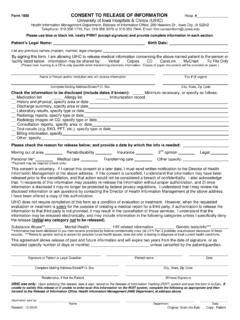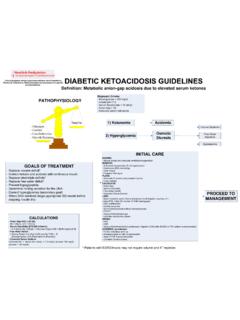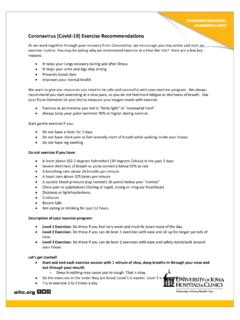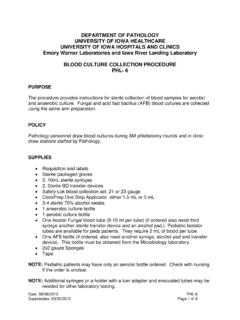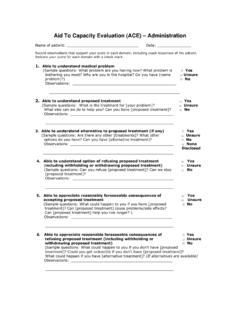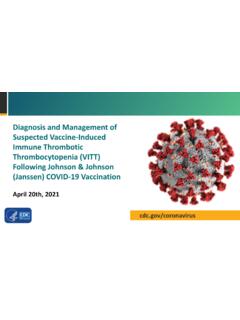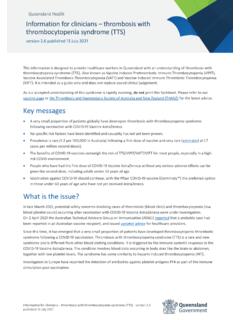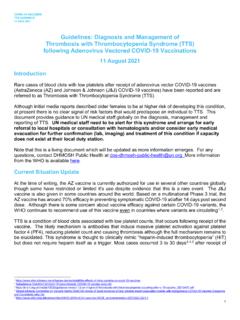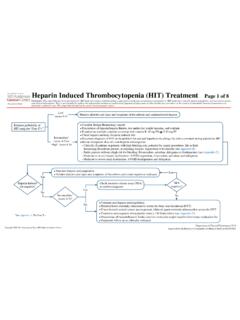Transcription of Heparin-induced thrombocytopenia Guideline
1 Page 1 of 12 Guidelines for Recognition and Management of Heparin-induced thrombocytopenia BACKGROUND Heparin-induced thrombocytopenia (HIT) is a life-threatening immune response to heparin (and its derivatives) that is associated with a high risk of thromboembolic complications; a risk that could increase with delay in diagnosis or increase in heparin dose (to treat unrecognized HIT-associated thrombosis), or through use of warfarin. The frequency of HIT varies from to 5%, depending on the patient population It is caused by IgG antibodies that recognize complexes formed between heparin and platelet factor 4, which results in platelet activation, endothelial cell injury, and increased thrombin MONITORING FOR HIT HIT can lead to life- and limb-threatening complications where a delay in diagnosis or inappropriate continuation of heparin could increase harm to the patient.
2 These considerations suggest that routine platelet count monitoring for HIT is appropriate in at least some clinical situations, and that the greater the risk of HIT (see Table 1), the stronger the rationale for regular It is important to note that a baseline and repeat platelet count should be performed in all patients who have received heparin within the past 100 days or where exposure history is In addition, patients should be evaluated for the risk of developing HIT prior to starting heparin or enoxaparin in order to determine the frequency of platelet monitoring. Table 1. Risk Factors for HIT2,3 Risk Factor Description Duration of therapy 11 to 14 days > 5 to 10 days > 1 to 4 days Type of heparin Unfractionated heparin > low molecular weight heparin * (enoxaparin) > fondaparinux Dose Manifesting: therapeutic > prophylaxis > flushes Immunizing: prophylaxis > therapeutic Recent exposure to heparin Received within last 100 days Type of patient Postsurgical > medical > obstetric Patient gender Females > males * Available randomized controlled trials comparing unfractionated heparin and low molecular weight heparin (LMWH) treatment for VTE do not support a lower risk for HIT with ,5 It is unclear if the absolute risk of HIT is so low that a true difference is difficult to prove or if there truly is no Examples of risk category and patients types.
3 High Risk (risk of developing HIT is > 1%)2 Surgical patients (especially orthopaedic, cardiac, vascular) receiving prophylactic or treatment doses of heparin > 4 days Intermediate Risk (risk of developing HIT is to 1%)2 Surgical patients receiving prophylactic enoxaparin or heparin flushes > 4 days Medical or obstetric patients receiving treatment doses or prophylactic heparin > 4 days Medical or obstetric patients receiving enoxaparin after first receiving heparin Low Risk (risk of developing HIT is < )2 Medical or obstetric patients receiving enoxaparin > 4 days or heparin flushes Any patient receiving heparin or enoxaparin < 4 days Page 2 of 12 Another consideration that supports a role for platelet count monitoring is that HIT antibody seroconversion and resulting typical-onset HIT usually occur during specific time periods following initiation of heparin (5 to 10 days for seroconversion and initial platelet count fall and 7 to 14 days for reaching the threshold defining thrombocytopenia ).
4 Further, rapid-onset HIT , where platelet count fall begins within 24 hours of staring heparin , is strongly associated with recent heparin exposure (within past 100 days, especially last 30 days).2 The decision to perform platelet count monitoring, and the intensity of such monitoring, depends on the patient s risk factors, particularly the type of heparin , duration of heparin therapy, and the type of patient. Therefore, it is appropriate to perform platelet count monitoring in certain clinical situations, and to focus platelet count monitoring during those times when HIT usually occurs (see Table 2).2 Table 2. ACCP Recommendations for Platelet Count Monitoring2 Platelet Count Monitoring Based on Patient Risk Category and History Medication Type of Dose Previous heparin Exposure* or Exposure History Unknown High Risk Intermediate Risk Low Risk Therapeutic Baseline, repeat within 24 hr of starting heparin Every 2 to 3 days from day 4 to 14 Every 2 to 3 days from day 4 to 14 Every 2 to 3 days from day 4 to 14 Prophylaxis Baseline, repeat within 24 hr of starting heparin Every-other-day from days 4 to 14 Every 2 to 3 days from day 4 to 14 Every 2 to 3 days from day 4 to 14 heparin Flushes (only applies if patient is receiving ongoing therapy)
5 Baseline, repeat within 24 hr of starting heparin No recommendation Every 2 to 3 days from day 4 to 14 No routine monitoring suggested Therapeutic Baseline, repeat within 24 hr of starting heparin No recommendation Every 2 to 3 days from day 4 to 14 No routine monitoring suggested Enoxaparin Prophylaxis Baseline, repeat within 24 hr of starting heparin No recommendation Every 2 to 3 days from day 4 to 14 No routine monitoring suggested Fondaparinux Any dose No routine monitoring suggested No routine monitoring suggested No routine monitoring suggested No routine monitoring suggested ACCP = American College of Chest Physicians * Previous heparin within previous 100 days Initiation day of heparin /enoxaparin is considered day 0 Page 3 of 12 Recommendations for platelet count monitoring at UIHC have been modified in order to minimize confusion and maintain patient safety (see Table 3).
6 Table 3. UIHC Recommendations for Inpatient Platelet Count Monitoring Medication Type Minimum Recommended Platelet Count Monitoring* Therapeutic or prophylaxis Baseline, repeat within 24 hrs, then every-other-day from day 4 to 14 heparin Flushes (only applies if patient is receiving ongoing therapy) Baseline, repeat within 24 hrs, then every 2 to 3 days from day 4 to 14 Enoxaparin Therapeutic or prophylaxis Baseline, repeat within 24 hrs, then every-other-day from day 4 to 14 Fondaparinux Any dose No routine monitoring suggested * Initiation day of heparin /enoxaparin is considered day 0 Patients who are not under close platelet count monitoring (patients who are discharged home on heparin or enoxaparin and/or are continued on therapy after 14 days) should be informed of the most common resulting signs and symptoms of HIT ( , new thrombosis and painful skin lesions at the heparin injection sites), and be advised to seek medical advice immediately if these events Furthermore, the American College of Chest Physicians (ACCP) recommends that outpatients receiving prophylaxis or treatment doses of heparin should sign an informed consent which includes HIT and its typical sequelae and the advisement that the patient should seek medical advice if these events occur (Grade 2C recommendation).
7 2 WHEN SHOULD HIT BE SUSPECTED? Because the diagnosis is based on both clinical and serologic grounds, clinicians should consider HIT a clinicopathologic Thus, neither thrombocytopenia or thrombosis without the presence of heparin -dependent antibodies, nor the isolated presence of antibodies without thrombocytopenia , thrombosis, or other clinical sequelae, meet the criteria for The following are situations where HIT should be suspected: Patient presenting to the emergency room with signs / symptoms of DVT or PE five to 100 days after hospital discharge (assumes patient was exposed to heparin on previous admission) The American College of Chest Physicians recommends that the diagnosis of HIT should be considered in patients who are receiving heparin or have received heparin within the previous 2 weeks if the platelet count decreases by 50% (even if platelets > 150,000 per L)and/or a thrombotic event occurs between days 5 and 14 following initiation of heparin (even if the patient is no longer receiving heparin therapy when the thrombosis or thrombocytopenia has occurred)2 Platelet count fall within 24 hours of heparin or enoxaparin in the setting of previous heparin exposure (within previous 100 days, especially within the last 30 days)
8 An otherwise unexplained platelet count fall (defined by various investigators as a minimum platelet count fall of 30%, 40%, or 50%) even if the platelet count nadir remains > 150,000 per L2 Patient receiving heparin or enoxaparin when a thrombotic event occurs (with or without thrombocytopenia ) o Up to 25% of HIT patients will experience a thrombotic event during heparin treatment before HIT-associated platelet fall6 o Previous exposure (within previous 100 days): thrombosis may occur immediately2 o A delayed thrombotic response may occur up to 100 days post-initial exposure2 Anaphylactoid reactions2 Page 4 of 12 o Rarely, patients develop acute inflammatory ( , fever, chills, flushing) or cardiorespiratory ( , hypertension, tachycardia, dyspnea, chest pain, cardiorespiratory arrest) symptoms and signs within 30 minutes following an IV heparin bolus (or subcutaneous LMWH).
9 O This presentation mandates a prompt platelet count measurement and comparison to recent prior platelet counts, as an abrupt platelet count fall in this clinical context supports the diagnosis of HIT. The platelet count drop is frequently transient, and thus a delay in determining the platelet count, especially if heparin is stopped, may result in a missed diagnosis. Atypical inflammatory skin reactions at heparin or enoxaparin injection sites WHAT TO DO IF HIT IS SUSPECTED 1. Estimate the probability of HIT Clinicians should consider a diagnosis of HIT when thrombocytopenia occurs with a temporal pattern consistent with heparin -immunization (platelet count fall begins 5 to 10 days after start of therapy) or when thrombosis or other sequelae of HIT occur in patients treated (or recently treated) with The pretest estimation of the probability of HIT is influenced by the temporal features of the platelet count fall and by the likelihood of other possible alternative diagnoses to explain the thrombocytopenia (see Figure 1).
10 2 Prospective and retrospective evaluations of the 4 T s scoring system8 (a system to help physicians estimate the pretest probability of HIT) have indicated that low scores have very low likelihood of HIT, whereas a high score is associated with moderate to high risk of Figure 1. Estimating the Probability of HIT8 Page 5 of 12 2. Determine action based on probability of HIT Table 4. UIHC Recommended Action Based on Probability of HIT 2,3,9-11 Probability Score Actions Low (0 to 3) HIT unlikely heparin or enoxaparin may continue, but consider use of fondaparinux; Consider Hematology consult if inciting incident for suspicion of HIT is thrombosis; Continue to monitor platelets as above (Table 2) and observe for signs/symptoms of thrombosis; and Continue to evaluate the probability of HIT based on the 4T s scoring system as laboratory values are reported or other signs and symptoms develop (see Figure 1) Intermediate (4 to 5) Or High (6 to 8) HIT possible Discontinue all heparin * or enoxaparin; Order a heparin platelet factor 4 antibody (PF4 EIA, aka heparin -dependent antibody); List heparin or enoxaparin as allergy in the patient s allergy list in IPR and medical record.
